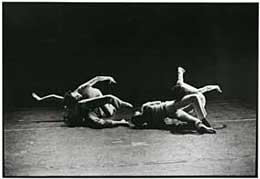We typically think of our bodies as flesh, muscles, and bone - concrete and corporeal. What if we were to revise our perception and concentrate on something more dynamic? More liquid? The body is, after all, 8o percent water. The theory of Fluid Systems, established by Bonnie Bainbrige-Cohen of the School for Body-Mind Centering, in Amherst, Mass asks these very questions and attempts to gain a deeper understanding of the body through such a revised perception. The insights gained hold-exciting clues for understanding the workings and reality of the body.
According to Bainbrige-Cohen there are six major fluids in the body; cellular fluid, intercellular fluid, blood, lymph, cerebrospinal (CSF) and synovial. All of the fluids are interrelated though each possesses its own rhythm, characteristics and "mind-state". There are also specific exercises for accessing, identifying and working with each fluid.
Cellular fluid, the fluid within each individual cell is the most basic fluid state and its characteristics are those of rest, presence and beingness. To understand the movement-by-movement presence of cellular fluid, sit still in a meditative state and try to feel the slow, rhythmic, ever-present breathing occurring in each cell of your body.
Intercellular fluid is a conduit of nutrients, a spongy ocean in which cells float. You can conceptualize this versatile and vital connective fluid by squeezing and releasing your fist. Intercellular fluid works in this way to facilitate the flow of fluid in and out of the cells.
|

" Honor " 1998
by Paul Langland |
Photo:Paula Court
|
|

Paul Langland
" Honor " 1998 |
Photo: Paul Courtl
|
Wrestling if another activity that both mimics and accesses intercellular fluid.
Blood is perhaps the most familiar fluid. The arterial blood flow carries oxygenated blood form the heart to the body. The deoxygenated blood is carried back to the heart by the venous flow. Arterial flow is characterized by a sharp, regular rhythm, the beating of your heart. Venous flow resembles a swooshing, wave-like movement, a never-ending rise and fall back toward the heart. We access our arterial flow every time we perform an aerobic activity such as running. Venous flow is felt in graceful undulations such as swinging.
Lymph eliminates infection and excessive proteins preventing any harmful substances from blocking the regular flow of fluids. The mind-state of lymph is characterized by specificity, clarity, and directness. To identify the lymphatic flow, perform movements and activities that require precision and directness.
Cerebrospinal fluid flows along the length of the spinal column from the brain to the sacral region. It's characteristically slow and meditative like the cellular fluid, yet lighter and more effortless. Playing with soap bubbles will give you a feel for the easy, trance-like rhythm of CSF.
Synovial fluid, the fluid of the skeletal system, lubricates and nourishes the connective tissues of the joins. Loose, rubbery, juggling movements correspond to this fluid. Its mind-state if often carefree and playful, occasionally jittery.
It's not all science.
|